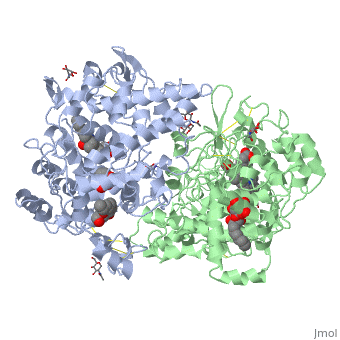Aspirin, also known as acetyl salicylic acid or ASA, has been used as an antipyretic drug (reduces fever) and as an anti-inflammatory agent (reduces swelling and redness due to inflammation) from ancient times. Chewing on willow bark was a headache and toothache remedy for American Indians[1], and Dioscorides, the first century Greek physician, recommended it as a poultice for treating inflammation in his De Materia Medica Libri .[2]. Aspirin is in the family of drugs known as NSAIDs, which stands for NonSteroidal AntiInflammatory Drugs.
While the use of aspirin goes back to ancient times, the mechanism of how aspirin relieves pain is relatively modern. In 1971, John Vane discovered that aspirin works by inhibiting the synthesis of prostaglandins [3], and he recieved a Nobel Prize for this work in 1982 [4]. In 1975 Roth, Standford, and Majerus identified prostaglandin H2 synthase, also referred to as cyclooxygenase (COX), as the enzyme that aspirin inhibits[5].
PGHS contains two identical polypeptide chains, shown in blue and green in the box at the right. The enzyme catalyzes two reactions: first, the reacts with the oxygen to create a peroxide at ; in the second reaction, the peroxide is added to the double bond in arachadonic acid.
Aspirin works by transferring the acetyl group (CH3COO-) of aspirin to the OH of the . When this residue is acetylated, arachidonic acid can no longer be bound because there is no longer room for it to fit in the enzyme. Since the acetylation cannot be undone, this is a "suicide" inhibitor--the inhibition cannot be undone, and the enzyme is dead.

